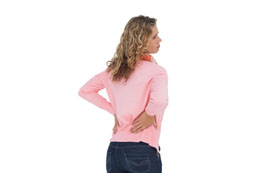Lumbar spondylosis is seen when there is compression of the spine or the nerves in the lower back region. Read on to know all about the symptoms and treatment of this condition.

Lumbar spondylosis is a condition where there is pain in the lower back. This spondylosis normally affects people that are over the age of forty. Usually, multiple levels of the vertebrae are involved in this disease. The lumbar spine is the region that carries most of the body's weight, thus, degenerative forces compromise the structure and function of this region of the spine. Spondylosis is normally characterized by slippage of one vertebra over the other. There is misalignment of the spinal cord and vertebrae, leading to narrowing of the canal. The nerves that come out of the spine also get compressed, due to which the person gets the symptoms. There are many other causes like physical trauma to the spinal region, sitting for prolonged periods of time, lifting very heavy weights repeatedly, etc. Sometimes, even genetic factors may play a role in spurring this condition. Given below are the symptoms and various treatment measures of dealing with spondylosis of the lumbar region.
Symptoms
Symptoms associated with spondylosis of the lumbar vertebrae will vary depending on the activity levels, the weather influences, and the region and vertebra that is being affected by the compression. One of the common complaints of most patients is morning stiffness. Stiffness and pain in the lower back often radiates towards the buttocks, leading to sciatica, which may be a serious symptom. This may be accompanied by changes in activity of the bowel and bladder. There may also be tingling and muscle spasms along with the back pain. The extremities may get numb or may suffer from paresthesia. Sleeping or lying down on the back may get painful, which could lead to progressive spinal deformity.
Treatment
As such, treatment will vary depending on the exact cause and region of spondylosis. However, there are many simple changes that can help to considerably relieve the pain and symptoms. These include:
- Modifying lifestyle, especially occupational changes if your work involves heavy manual labor, helps greatly in preventing pain.
- Losing weight and quitting smoking also helps to provide relief.
- A corset or brace can be used to provide support to the lower back region.
- If the pain is unbearable, then anti-inflammatory medication can be given, along with muscle relaxants and pain killers. The person also needs to take adequate amount of rest.
- Application of wet pack after giving local steam to the painful region also helps to provide substantial relief. Use of a thin mattress or a hard bed are recommended in cases of people suffering from spondylosis in the lumbar region.
- A healthy change in dietary lifestyle, coupled with adequate amount of exercise, will also help to mitigate the symptoms.
Exercises
There are many yoga positions that help to relieve pain and stretch the muscles. There are also many stretches that a person can do to help relieve the compression in the spinal region. The goal of stretching is to improve flexibility and decrease the rigidity of the spine. One of the stretches is to get on your hands and knees. Then, breathe in as you slowly raise your head while allowing the muscles of your back to stretch. Breathe out while dropping your head and raising your back. Hold your head and back in this position for a while before repeating this exercise ten times. Try to increase your range of motion on each movement.
As the saying goes, prevention is always better than cure. Hence, one can always try and delay the onset of lumbar spondylosis by maintaining a healthy lifestyle supplemented by proper diet and exercise.


 Lumbar spondylosis is a condition where there is pain in the lower back. This spondylosis normally affects people that are over the age of forty. Usually, multiple levels of the vertebrae are involved in this disease. The lumbar spine is the region that carries most of the body's weight, thus, degenerative forces compromise the structure and function of this region of the spine. Spondylosis is normally characterized by slippage of one vertebra over the other. There is misalignment of the spinal cord and vertebrae, leading to narrowing of the canal. The nerves that come out of the spine also get compressed, due to which the person gets the symptoms. There are many other causes like physical trauma to the spinal region, sitting for prolonged periods of time, lifting very heavy weights repeatedly, etc. Sometimes, even genetic factors may play a role in spurring this condition. Given below are the symptoms and various treatment measures of dealing with spondylosis of the lumbar region.
Lumbar spondylosis is a condition where there is pain in the lower back. This spondylosis normally affects people that are over the age of forty. Usually, multiple levels of the vertebrae are involved in this disease. The lumbar spine is the region that carries most of the body's weight, thus, degenerative forces compromise the structure and function of this region of the spine. Spondylosis is normally characterized by slippage of one vertebra over the other. There is misalignment of the spinal cord and vertebrae, leading to narrowing of the canal. The nerves that come out of the spine also get compressed, due to which the person gets the symptoms. There are many other causes like physical trauma to the spinal region, sitting for prolonged periods of time, lifting very heavy weights repeatedly, etc. Sometimes, even genetic factors may play a role in spurring this condition. Given below are the symptoms and various treatment measures of dealing with spondylosis of the lumbar region.